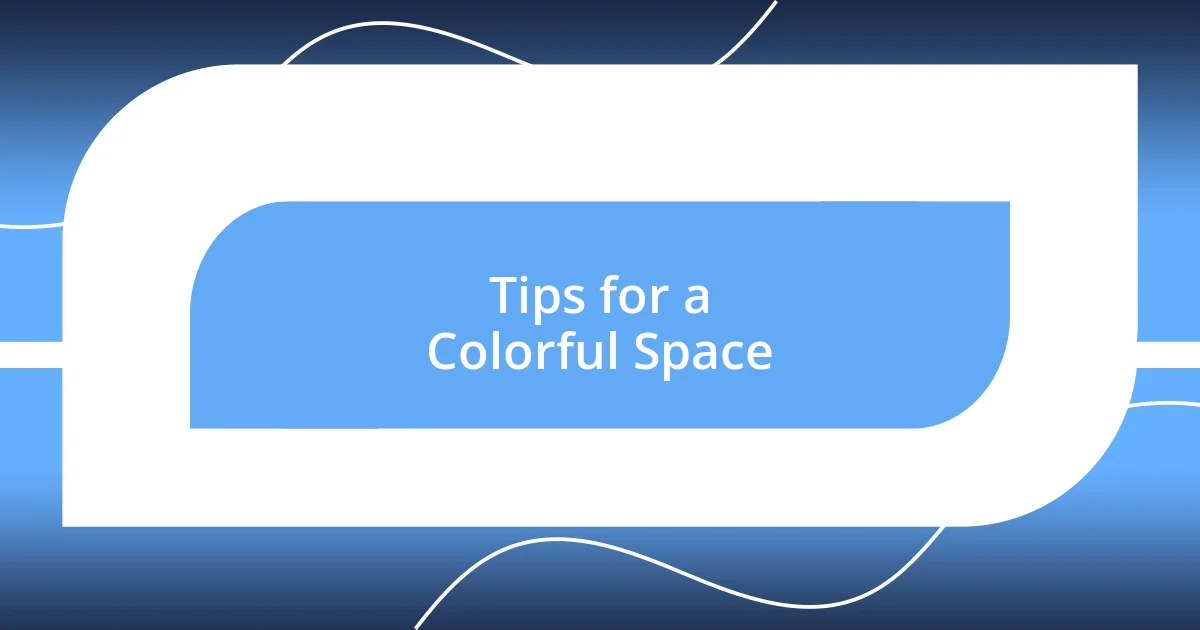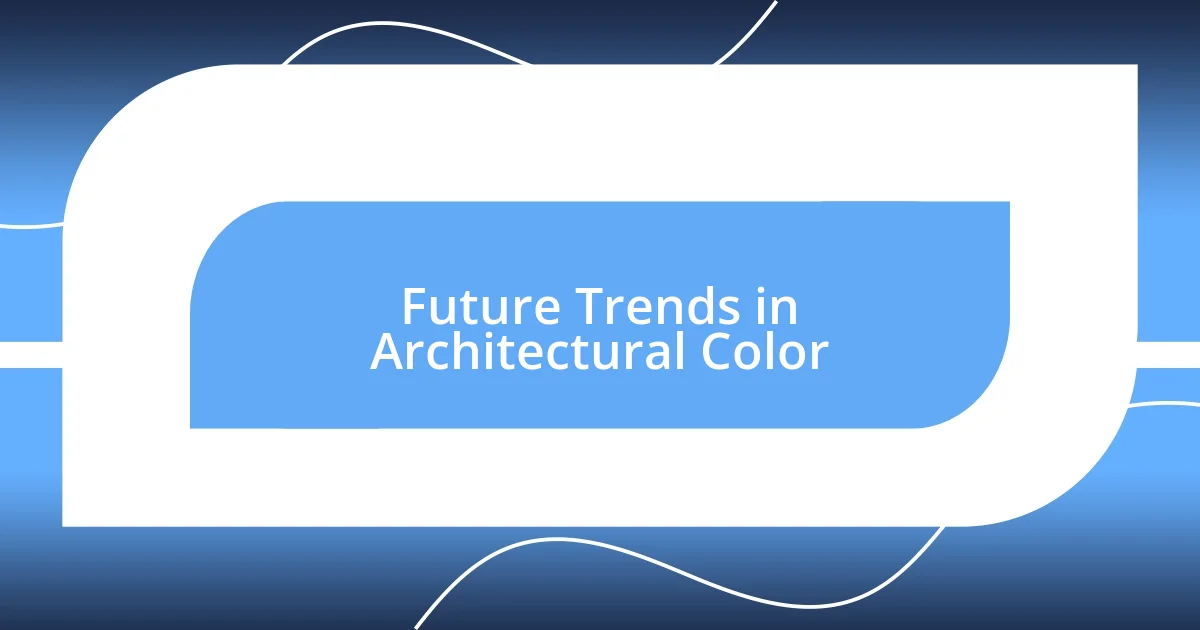Key takeaways:
- Color in architecture influences emotions and behaviors, creating a unique sense of community identity and cultural expression.
- Historical perspectives reveal color’s practical and aesthetic significance, tied to cultural beliefs and environmental needs.
- Future architectural trends will focus on technology, sustainability, and diverse cultural expressions, enhancing the dynamic interaction between buildings and their surroundings.

Understanding Color in Architecture
Color in architecture is more than mere aesthetics; it can evoke feelings and influence behaviors. I still remember walking through a vibrant neighborhood where every building danced with bold hues—each color telling its own story. Have you ever noticed how a bright yellow facade can lift your spirits while walking down the street?
In my experience, the psychological impact of color can be profound. For instance, I find that blues and greens create a sense of calmness, often leading me to daydream or reflect while working in spaces painted in those tones. Why do you think hospitals often use soft colors? It’s not just design; it’s a thoughtful choice aimed at soothing anxious patients and families.
Moreover, color can anchor a community’s identity. When I visited a city well-known for its colorful architecture, I felt a sense of belonging despite being a tourist. Those hues, representing culture and history, invite connection. What role do you think color plays in how we perceive and experience our surroundings? Through thoughtful color application, architects can transform a mere structure into a home, a haven, or a hotspot.

Importance of Color Choices
Color choices in architecture are essential as they can profoundly impact our emotions and experiences. For instance, I remember visiting a quaint café with pastel pink walls, which made the atmosphere feel warm and inviting. When I settled into a cozy corner, the color enveloped me like a gentle hug, nurturing a sense of comfort that encouraged me to linger longer. Isn’t it interesting how a simple color can change your entire mood?
In a professional setting, color choices can significantly affect productivity and creativity. I once worked in an office painted in neutral grays, and while it was sleek, it lacked energy. On the other hand, when I shifted to a space adorned with splashes of orange and green, my creativity soared. Those bright tones seemed to ignite inspiration, transforming mundane tasks into exciting challenges. What colors have you found to spark your creativity?
Finally, color plays a crucial role in cultural expression within architecture. I recall visiting a neighborhood rich in cultural heritage where each building was painted in colors that reflected the local traditions. It felt like walking through a living gallery! The vibrant blues and reds told stories of the community’s past, creating a nostalgic atmosphere that resonated deeply with me. This connection between color and cultural identity truly emphasizes how vital our choices are in shaping the neighborhoods we inhabit.
| Color Choice | Impact |
|---|---|
| Warm Colors (e.g., red, orange) | Stimulate energy and creativity |
| Cool Colors (e.g., blue, green) | Create calming and soothing environments |
| Neutral Colors (e.g., gray, beige) | Provide balance but may lack dynamism |

Historical Perspectives on Color
Throughout history, color in architecture has held varied meanings and functions, often influenced by cultural, social, and economic factors. I remember exploring the ancient cities of the Mediterranean, where the use of whitewashed buildings was not merely about aesthetics, but also a way to reflect harsh sunlight and keep interiors cool. It struck me how practical choices about color can also stem from environmental considerations, leaving a lasting architectural legacy.
- Ancient Rome frequently utilized earth tones to evoke a sense of stability and permanence.
- In traditional Japanese architecture, the use of natural colors harmonizes structures with their surrounding landscapes, embodying the principle of “wabi-sabi,” which celebrates imperfection and transience.
- The Renaissance period embraced vibrant colors, often associating them with wealth and power, as seen in the palaces of Florence and Venice.
These historical perspectives reveal how color is interwoven with practicality, emotion, and cultural beliefs, shaping the experience of spaces through time.

Techniques to Incorporate Color
When it comes to incorporating color in architecture, I’ve found that layering colors can create a dynamic visual experience. For instance, I once visited a library where the walls gracefully transitioned from a deep navy at the base to a soft sky blue at the top. This gradient effect not only drew my eyes upward, evoking a sense of openness, but also made me feel as though I was stepping into an expansive sky. Have you ever noticed how a simple transition can transform a space?
Another technique I love is using accent colors strategically. In my own home, I painted one wall a bold coral while keeping the rest neutral. The vibrant wall instantly became a conversation starter, bringing warmth and energy to my living room. This accent wall allowed me to express my personality without overwhelming the space. What accent colors have you played with that sparked joy in your own environment?
Textures also play a crucial role in how color is perceived. I remember walking through a modern art museum featuring colorful murals alongside polished concrete. The contrast created a stunning interplay where the vivid colors seemed to vibrate, enveloping me in a lively atmosphere. It reminded me that adding texture can enhance color, enriching our experience of any architecture. Isn’t it fascinating how different elements can complement each other so beautifully?

Case Studies in Colorful Architecture
When exploring case studies in colorful architecture, I recall a visit to the vibrant streets of Burano, Italy. Each building was a different hue, creating a visual feast that felt almost magical. Walking along those canals, I couldn’t help but wonder how the locals chose such bold colors. The story goes that fishermen painted their homes in bright shades to help them find their way back in thick fog, blending practicality with joyful aesthetics.
Another fascinating example is the works of architect Frank Gehry. I once marveled at the Guggenheim Museum in Bilbao, Spain. Its irregular shapes and metallic surfaces catch the light in such a way that the building seems to change color as the sun moves across the sky. Isn’t it incredible how dynamic architecture can evoke different emotions at various times of the day?
In Mexico, the town of Oaxaca presents a striking case with its use of vibrant colors in traditional buildings. I remember strolling through the colorful streets, feeling energized by the bold yellows, turquoise, and reds. This isn’t just about aesthetics; it reflects cultural identity, celebrating heritage and community spirit. Doesn’t it make you think about how color can foster a sense of belonging?

Tips for a Colorful Space
One of my favorite tips for creating a colorful space is to experiment with color-blocking. A few years back, I decided to paint my kitchen cabinets in a vibrant turquoise while opting for a warm peach on the walls. The result was an unexpected yet refreshing energy that turned mundane cooking into a joyful experience. Have you ever considered how a simple color choice can transform your daily tasks into something more enjoyable?
Lighting is another essential element to consider when working with color. During a lighting redesign in my home office, I invested in warm LED bulbs that brought out the richness of my deep green walls. The way the light bounces off the colors can completely change the mood. I often find myself asking, how much do we underestimate the power of good lighting in showcasing our beloved colors?
Lastly, don’t shy away from incorporating artwork or decor that celebrates vibrant colors. I vividly recall visiting a friend’s apartment adorned with bold abstract paintings hanging against a neutral backdrop. Each piece told a story while adding layers of personality to the room. It made me realize that art can be a powerful vehicle for color expression. What pieces do you have in your space that make you feel more alive?

Future Trends in Architectural Color
As I look ahead, I see a vibrant future for architectural color that embraces technology and sustainability. Imagine buildings clad in color-changing materials that react to environmental conditions or even the mood of the space. I remember reading about smart glass that shifts colors throughout the day – how exciting would it be if our buildings could do the same? This evolving palette can redefine how we interact with our surroundings, making architecture not just a visual experience but a dynamic one.
One trend that truly captivates me is the integration of biophilic design principles, which connect architecture with nature. I recently visited a new office complex that seamlessly blends greenery and color; the use of earthy tones combined with vivid plant life created an atmosphere of tranquility and creativity. Doesn’t it make you wonder how this fusion of colors and natural elements can enhance our well-being and productivity? It’s fascinating to think about how these design choices can evoke a sense of calm while also inspiring innovation.
Moreover, I believe we’re going to see a further push towards diverse cultural expressions in architectural color. Reflecting on my travels, I’ve often been struck by how different regions use color to encapsulate their identity. For me, experiencing the rich textiles and hues of African architecture was a revelation. This inclusivity in architectural color can deepen our understanding of different cultures and histories. How can we, as architects and designers, ensure that our designs tell these vibrant stories? Incorporating these diverse narratives through color is not just an aesthetic choice; it’s a celebration of human expression.














